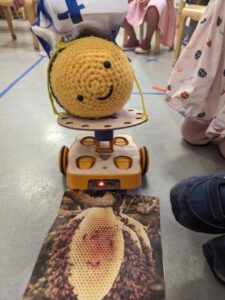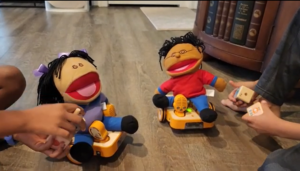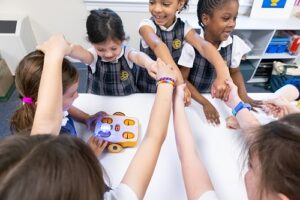Engineering a KIBO Carousel
Contributed by: My First Skool, Singapore, http://www.myfirstskool.com/

The PlayMaker Programme launched by the Singapore Infocomm Media Development Authority of Singapore (IMDA) introduced a suite of technology-enabled toys to pilot at 160 preschool centres as a start. KIBO was selected as one of tech toys, and Westgate Centre was one of the preschool centres that embarked on PlayMaker. The centre has been championing the use of tech-enabled toys and constantly reviewed the use of these tech-enabled toys for teaching and learning. They shared the following description of a KIBO activity the students and teachers undertook together.
“Recently, the K1 children from Westgate Centre have shown curiosity and interest in a carousel ride that was set up near Westgate Mall (where the centre is located) during one of their outdoor lessons. They were particular curious about the way the carousel moved. The teachers and children then decided to create a carousel as part of their project to showcase the use of technology at an upcoming Learning and Sharing Festival.
Various pictures of carousels were shown to the children as a reference. The children and teachers planned and decided on the design and colours of the carousel, working together in creating a carousel of their own. After designing, the children decided that they wanted to make the carousel spin like the real carousel they saw at the mall.
The K1 children and teachers tried to make the carousel spin by programming KIBO with the “spin” and “repeat” blocks (i.e. repeat spinning). They observed that this programming caused KIBO to spin too quickly and the carousel kept “flying” off.
The K1 teachers decided to seek other level teachers’ opinions. Teachers discussed collaboratively and tried different programming blocks such as “begin”, “repeat”, “forever”, “turn right”, “end repeat” and “end”. They noticed that the spinning slowed with pauses in between each right turn, but the carousel was still falling off. After various attempts, the teachers observed that the movement of the wheels were spinning the carousel off KIBO. So in their final attempt, they removed KIBO’s wheels (who said KIBO always need wheels?) and found that the carousel stayed intact and was able to spin at the same place!
Westgate carousel was finally spinning like a carousel, but one of the K1 children highlighted to her teachers on the use of light bulb to light up the carousel like the real one. “Light” blocks were immediately put to good use together with the 4 coloured light bulbs and Westgate carousel was finally completed!
Though it may appear to be a simple carousel, the teachers and children went through a process to solve different problems they encountered throughout the project, and they were also required to communicate with their peers and teachers on the design and to solve the problems they faced. The used of tech-enabled toys allowed teachers and children to “tinker” with opportunities to constantly try and redo. This project helped both our teachers and children learn through play and also built a wonderful carousel that they were very proud to showcase at the Learning and Sharing Festival.”





















